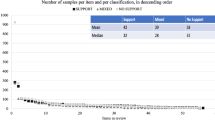Abstract
A better understanding of the general processes involved in bilingual children's metaphorical reasoning was determined by conducting comparative research with children from bilingual and unilingual backgrounds. Two tests of metaphor as well as the Ravens Coloured Progressive Matrices Test (RCPMT) were administered to 30 bilingual Canadian-Greek children and to 30 unilingual Canadian children aged 8 and 11 years. The Proverbs Test (a verbal metaphorical test) and the Metaphoric Triads Task (MTT — a nonverbal pictorial test) were administered to both linguistic groups. There were no significant differences between the two linguistic groups on the RCPMT and the MTT. The only significant difference between the Canadian-Greek and the Canadian children was that the former correctly preferred the moral of the proverbs in the Proverbs Test to a greater extent than did the Canadian children. The results are discussed with respect to bilingualism and cross-cultural comparisons of cognitive constructs. The implications of the study for bilingual education are also discussed.
Résumé
Une meilleure compréhension des processus généraux impliqués dans l'utilisation de la métaphore chez des enfants bilingues a été recherchée par la comparaison d'enfants unilingues et bilingues. Deux textes sur la compréhension des métaphores et le Ravens Coloured Progressive Matrices (RCPMT) ont été soumis à 30 enfants bilingues (Canadiensgrecs) et 30 enfants unilingues (Canadiens) âgés de 8 et 11 ans. Le Proverbs Test (test verbal sur les métaphores) et le Metaphoric Triads Task (MTT, test figuratif, à support non verbal) ont été appliqués aux deux groupes linguistiques. Aucune différence significative n'a été mise en évidence sur le RCPMT et sur MTT. La seule différence significative entre les enfants canadiens-grecs et les enfants canadiens indique que les premiers, plus fréquemment que les seconds, identifient correctement la morale correspondant aux proverbes qu'ils doivent interpréter. Les résultats sont discutés à la lumière de considérations sur le bilinguisme et les comparaisons interculturelles dans l'étude de la construction cognitive. Les implications de cette recherche pour l'éducation bilingue sont également analysées.
Similar content being viewed by others
References
Anastasi, A. (1983). Evolving trait concepts. American Psychologist, 38, 175–184.
Billow, R. M. (1975). A cognitive developmental study of metaphor comprehension. Developmental Psychology, 11, 415–423.
Bountrogianni, M. (1985). A cross-cultural study of children's competence in making similarity judgements. Paper presented at the Biennial Meeting of the Society for Research in Child Development, Toronto, Ontario.
Boswell, D. A. (1979). Metaphoric processing in the mature years. Human Development, 22, 373–384.
Cummins, J. (1984). Bilingualism and Special Education: Issues in Assessment and Pedagogy. Clevedon, Avon: Multilingual Matters Ltd.
Cummins, J. (1981). The Role of Primary Language Development in Promoting Educational Success for Language Minority Students. In California State Department of Education (Eds.), Schooling and Language Minority Students: A Theoretical Framework. Los Angeles, CA: Evaluation, Dissemination and Assessment Center.
Cummins, J. (1980). Educational Success for Canadian Minority Language Children: The Role of Mother Tongue Development. Monograph, Ontario Institute of Studies in Education.
Cummins, J., & Mulcahy, R. (1978). Orientation to language in Ukranian-English bilingual children. Child Development, 49, 1239–1242.
Djap, D. (1983). Assessing the development of part-whole reasoning skills. Unpublished doctoral dissertation, University of Toronto, Toronto, Ontario.
Honeck, R. P., Voegtle, K., Dorfmueller, M. A., & Hoffman, R. R. (1980). Proverbs, Meaning, and Group Structure. In R. Honeck & R. Hoffmann (Eds.), Cognition and figurative language. Hillsdale, N. J. Erlbaum.
Hoover, W. (1983). Language Learning in Bilingual Instruction: Cantonese Site Analytic Study. Austin, Texas: Southwest Educational Development Laboratory.
Kessler, C., & Quinn, M. E. (1980). Positive effects of bilingualism on science problem solving abilities. In J. E. Alatis (Ed.), Georgetown University Round Table on Languages and Linguistics. Washington, D. C.: Georgetown University Press.
Kogan, W., Connor, K., Gross, A., & Fava. D. (1980). Understanding visual metaphor: Developmental and individual differences. Monographs of the Society for Research in Child Development: Vol. 45 (1 Serial No. 183). Understanding visual metaphor: Developmental and individual differences. Chicago: University of Chicago Press.
Author information
Authors and Affiliations
Additional information
The results of this study were presented at the Canadian Psychological Association Conference, Toronto, 1986.
Rights and permissions
About this article
Cite this article
Bountrogianni, M. Bilingualism and metaphor comprehension. Eur J Psychol Educ 3, 53–64 (1988). https://doi.org/10.1007/BF03326307
Received:
Revised:
Published:
Issue Date:
DOI: https://doi.org/10.1007/BF03326307



